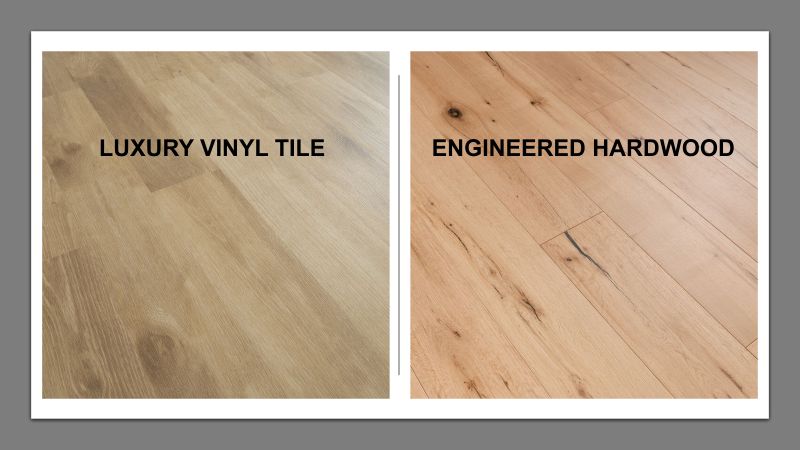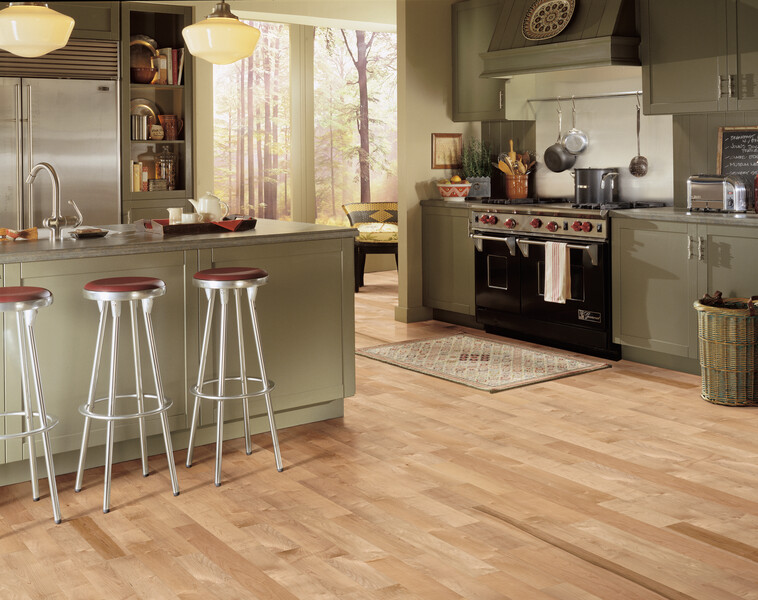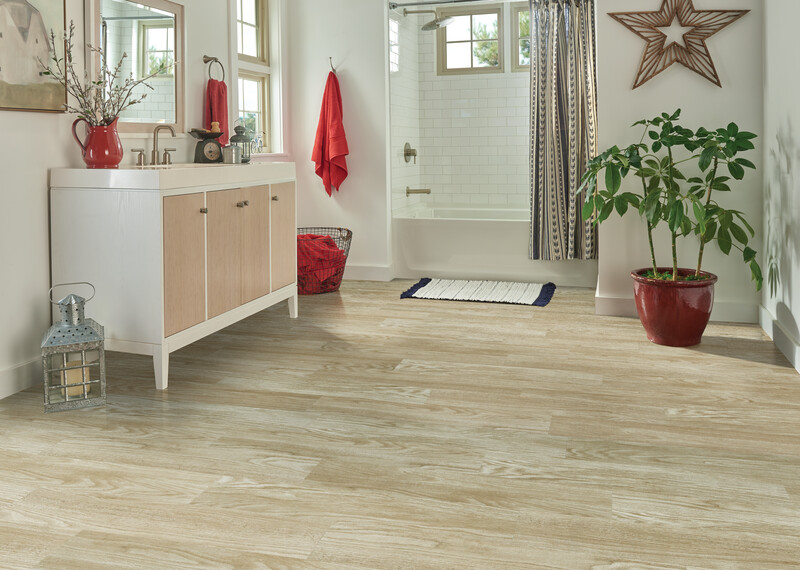Engineered Wood Flooring vs. LVT – Which to Choose
By Bruce Flooring Expert, Published August 21, 2025
Picking the right flooring can feel like a tug-of-war between looks, durability, and cost. Two of the most talked-about options right now?
Engineered wood flooring and luxury vinyl tile (LVT) offer a modern, stylish finish, but they have considerably different compositions.
Most importantly, what works in one room (or for one lifestyle) might not work in another. And that’s the key to helping you decide which to use in your home.
We’ll compare engineered hardwood flooring and LVT flooring side by side. No hype. Just a clear look at how each performs, what it costs, and where it fits best in your home.
Let’s start by understanding how they differ.

What Is Engineered Wood Flooring?
Engineered wood flooring features a real wood top layer, commonly referred to as a veneer. This top layer binds to several layers of plywood or fiberboard below. The upside is that you get a real hardwood floor. No one will ever be able to tell the difference.
The chief benefit is that it offers more stability and resists humidity changes better than solid hardwood flooring.
Let’s reiterate that engineered floors utilize a genuine hardwood wear layer. As a result, they showcase the texture, grain, and variation of wood species like oak, maple, or hickory.
Depending on the thickness of the top layer, you can refinish an engineered hardwood floor one or two times.
What Is Luxury Vinyl Tile?
Luxury vinyl plank flooring, or luxury vinyl tile (LVT), is a synthetic product, not real wood. It consists of several layers of plastic and vinyl pressed together.
The top layer is a clear, durable coating that resists scratches and dents quite nicely. Underneath that, a design layer mimics the appearance of wood. A rigid core follows that layer with a backing for stability.
One of LVT’s standout features is its water resistance. Many LVT products are fully waterproof, ideal for kitchens, bathrooms, basements, and high-traffic areas. And while LVT isn’t real wood, advances in printing and texturing make it look surprisingly realistic.
Engineered Wood Flooring vs LVT – A Comparison
Let’s compare how these two types of flooring stack up in key areas.
Appearance and Feel
Engineered hardwood flooring uses natural wood, so you get genuine texture and variation that you can’t perfectly replicate. Conversely, LVT is synthetic and can only mimic the look of natural wood. Although high-end options come close, they still lack the genuine feel of genuine hardwood flooring.

Durability and Water Resistance
Engineered wood floors are more stable than solid hardwood, delivering better water resistance. However, they’re still vulnerable to standing water. Therefore, you should clean up spills promptly.
Although they deliver improved scratch resistance compared to solid hardwood, they aren’t immune to scratching and deep scratches.
On the other hand, luxury vinyl planks are waterproof. Moreover, one of their substantial upsides is scratch resistance, which makes them better suited for moisture-prone and high-traffic areas.
Note that some manufacturers, such as Bruce®, offer waterproof engineered hardwood offerings like Hydropel®. It features six water-protection dimensions to keep planks safe from water.
Maintenance
Engineered hardwood requires regular sweeping and occasional damp mopping (no soaking!). Remember, it still features a wood surface layer and is more delicate around spills.
LVT flooring is easy to maintain. Just sweep and mop — no special treatments needed.
Installation
You can install engineered wood floors using nailing, gluing, or floating methods. They’re easier to install than solid hardwoods, making them more DIY-friendly. However, you need some baseline skills to install them.
LVT is often click-lock or peel-and-stick, making it one of the easiest flooring options for DIY. It requires minimal tools. The most substantial challenge is cutting the floors to fit around fixtures and other obstacles.
Cost Per Square Foot
Although engineered hardwood typically costs less than solid wood flooring, it is more expensive than LVT.
Engineered wood generally costs $6-$12 per square foot for mid-grade quality (HomeAdvisor). Installation adds another $7.76-$12.55 per square foot (Homewyse).
On the other hand, LVT can cost as little as $2 per square foot, while higher-end options can run $10 per square foot (HomeAdvisor). Installation is generally substantially less than engineered wood, which costs $2-$6 per square foot (HomeGuide).
Lifespan and Resale Value
High-quality engineered hardwood flooring can last 20 to 30 years, especially if you refinish it.
Some companies, like Bruce, offer a limited lifetime residential warranty on select engineered hardwoods. For example, America’s Best Choice hickory and oak engineered hardwood flooring includes such a warranty.
Typically, engineered wood floors also add to a home’s resale value.
LVT flooring generally lasts 10–20 years. Unlike engineered wood flooring, you can’t refinish it, so when it wears out, you must replace it. Consequently, it may not enhance resale value as much as wood flooring.
When to Choose Engineered Wood Flooring
If your priority is authenticity and long-term value, engineered wood delivers where vinyl can’t. It offers the rich look and feel of real hardwood, with more stability than solid wood. Moreover, you’re investing in a natural material that elevates your space and holds its value over time.
Engineered wood is a strong choice if:
- You want the warmth and character of real wood.
- You’re updating a central living area where aesthetics and value matter.
- You don’t need full waterproofing and are okay with slightly more upkeep.
- You’re looking for a longer-term investment with high-quality finishes.
When to Choose LVT Flooring
If your lifestyle requires durability, water resistance, and low maintenance, LVT is a better choice.

Without flinching, it can withstand a beating from pets, kids, spills, and scrapes. And because it’s DIY-friendly and budget-conscious, it’s often the practical pick.
LVT makes more sense if:
- You need a water-resistant or waterproof kitchen, bathroom, or basement surface.
- You have kids, pets, or lots of foot traffic, and need something tough.
- You’re working with a tighter budget.
- You want a quick, DIY-friendly install that’s easy to maintain.
The Best Floor is the One That Fits Your Needs
So, between engineered wood flooring vs LVT, which one wins? The truth is, neither is “better” across the board. It depends on what matters most to you.
Want the charm and value of natural wood with more stability than solid hardwood flooring? Go with engineered hardwood. Looking for a no-stress, waterproof solution for your busy home? Vinyl plank flooring is tough to beat.
The best advice is to order samples, lay them out in your space, and see how they look in natural light. Then, test how they feel underfoot. That real-world context can be the tipping point.
Bruce offers quality engineered hardwood to fit most budgets, regardless of your choice. The company now also offers a range of wood-look alternatives, including LVT. So whatever type of wood floor you’re after, Bruce is your go-to choice. Their floors have been a staple in American homes since 1884.
